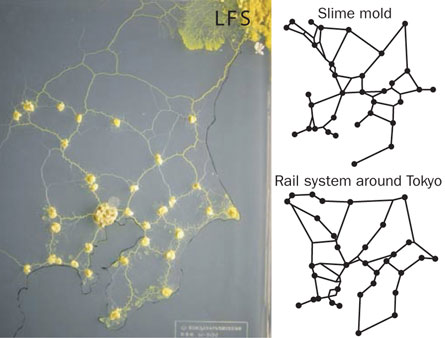Science Fiction
Dictionary
A B C D E F G H I J K L M N O P Q R S T U V W X Y Z
Slime Mold Network Engineering

Who would you ask to do the best possible job of connecting disparate locations with an efficient transport system? Engineers? Try slime mold.
In the picture shown below, researchers have carefully placed oat flakes in the pattern of Japanese cities around Tokyo. The slime mold Physarum polycephalum was introduced, eventually connecting the flakes with an efficient network to distribute nutrients throughout the single celled organism.
Transport networks are ubiquitous in both social and biological systems. Robust network performance involves a complex trade-off involving cost, transport efficiency, and fault tolerance. Biological networks have been honed by many cycles of evolutionary selection pressure and are likely to yield reasonable solutions to such combinatorial optimization problems. Furthermore, they develop without centralized control and may represent a readily scalable solution for growing networks in general. (1)

(Slime mold connects oat flakes like cities in Japan)
Initially, the slime mold dispersed evenly around the oat flakes, exploring its new territory. But within hours, the slime mold began to refine its pattern, strengthening the tunnels between oat flakes while the other links gradually disappeared. After about a day, the slime mold had constructed a network of interconnected nutrient-ferrying tubes. Its design looked almost identical to that of the rail system surrounding Tokyo, with a larger number of strong, resilient tunnels connecting centrally located oats. “There is a remarkable degree of overlap between the two systems,” Mark Fricker of the University of Oxford says. (2)
Fricker is one of several researchers contributing a paper this month to Science on using the slime mold’s behavior to create a biology-inspired mathematical description of network formation. In their research, the slime-based model first creates a fine mesh network that goes everywhere. The mathematical model uses an ongoing process to refine the network so that the tubes carrying the most material grow more robust and redundant tubes are removed.
It's not a prediction, but I'm reminded of the work of the clever intellectual cells in Greg Bear's wonderful 1984 novel Blood Music. In the story, they become more intelligent and, when introduced into the body of researcher Virgil Ulam, they restructure his body for greater efficiency, building networks that are actually visible across the surface of his skin.
If I can find my copy of the book, I'll drop in an appropriate passage. Unfortunately, Blood Music is not one of those books that stays put on your shelf; friends want to borrow it, you read parts of it and put it down somewhere.... you get the picture.
From (1) Rules for Biologically Inspired Adaptive Network Design via (2) Science News; thanks to an alert reader who passed on the tip about this great story.
Scroll down for more stories in the same category. (Story submitted 1/25/2010)
Follow this kind of news @Technovelgy.| Email | RSS | Blog It | Stumble | del.icio.us | Digg | Reddit |
Would
you like to contribute a story tip?
It's easy:
Get the URL of the story, and the related sf author, and add
it here.
Comment/Join discussion ( 0 )
Related News Stories - (" Biology ")
Black Fungus Blocks Radiation
'You were surrounded by Astrophage most of the time' - Andy Weir, 2021.
Lunar Biorepository Proposed For Cryo-Preservation Of Earth Species
'...there was no one alive who had ever seen them. But they existed in the Life Bank.' - John Varley, 1977.
Let's Make Slaver Sunflowers! Engineering Plants To Reflect Light
'The mirror-blossom was a terrible weapon.' - Larry Niven, 1965.
Machete-Wielding Philodendron Isn't Going To Take It Anymore
'The tree ended its wild larruping, stood like a dreaming giant liable to wake into frenzy at any moment.' - Eric Frank Russell, 1943.
Technovelgy (that's tech-novel-gee!) is devoted to the creative science inventions and ideas of sf authors. Look for the Invention Category that interests you, the Glossary, the Invention Timeline, or see what's New.
Science Fiction
Timeline
1600-1899
1900-1939
1940's 1950's
1960's 1970's
1980's 1990's
2000's 2010's
Current News
iPhone Air Fulfils Jobs' Promise From 2007 - A Giant Screen!
'... oblongs were all over the floor and surfaces.'
ChatGPT Now Participates in Group Chats
'...the city was their laboratory in human psychology.'
iPhone Pocket All Sold Out!
'A long, strong, slender net...'
Did The Yautja Have These First?
What a marvel of ingenuity the little device was!
Jetson ONE Air Races Begin, Can Air Polo Be Far Behind?
'If you're one of those rarities who haven't attended a rocket-polo "carnage", let me tell you it's a colorful affair.'
Will Space Stations Have Large Interior Spaces Again?
'They filed clumsily into the battleroom, like children in a swimming pool for the first time, clinging to the handholds along the side.'
Mornine Sales Robot
'Robot-salesmen were everywhere, gesturing...'
Bipedal Robot Floats Gently While Walking
'a walking balloon proceeded with long strides of its aluminum legs...'
Musk Idea Of Cars Talking To Each Other Predicted 70 Years Ago
'My cars talk to one another.'
Elegant Bivouac Shelter Produces Water And Electricity
'There was nowhere on the planet where science and technology could not provide one with a comfortable home...'
X-Control Janus-1 A Suitcase Aircraft
'You will notice that it... fits the suitcase nicely.'
'AI Assistants' Are Actually Less Reliable For News
'Most men updated their PIP on New Year's Day...'
YES!! Remote Teleoperated Robots predicted by Technovelgy!
'...a misshapen, many-tentacled thing about twice the size of a man.'
Will Robots Ever Fold Landry?
Where have you gone, Mrs. Robinson?
Will AIs Give Better Results If You're Rude To Them?
'I said, "Listen up, motherf*cker.'
Cybertruck Robotic Arm F10 Drone Launch!
Drone away!
